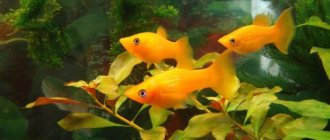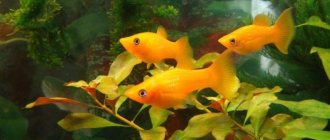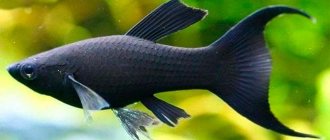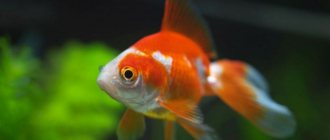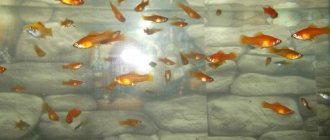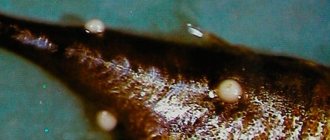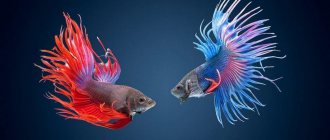Fish diseases
Mollies
Aquarium fish, like all other species of living beings, are susceptible to various diseases. If the disease is identified in a timely manner at the initial stage, then all methods can be taken to not only cure, but also save the fish. Many mollies diseases can be detected at an early stage.
Even hybrid forms of mollies have fairly strong immunity.
If we consider diseases, they are divided into several groups:
- infectious - pathogens are microorganisms. If an infected individual is not removed from the aquarium in time, other inhabitants may become infected;
- invasive – pathogens are unicellular and multicellular parasitic organisms;
- non-contagious - such infections appear if inappropriate conditions are created, care is provided rarely and/or of poor quality.
For treatment, you can use special chemicals that are sold in any specialty store. To remove some types of parasites, it is enough to create certain conditions within the eco-environment.
Description
There are a huge number of different colors of mollies. But there are three main types: sphenops, latipina, velifera. Each of them has special characteristics. Mollies sphenops, or black, is the most common species among aquarium fish lovers. It has a small body, thicker on the sides. The caudal fin, like all the others, is rounded and small. The molly has a small head with pronounced round eyes. The mouth seems to be raised upward. In females, their round abdomen is quite noticeable. Males are identified by their pointed anal fin.
Range and habitat
They inhabit the southeastern United States, Central America, northern and eastern South America. They live in calm bodies of fresh water, as well as in brackish water of river mouths and lagoons.
Moreover, the natural habitats and areas of different types of mollies, including both fresh and brackish, and even sea waters, differ from each other. Molliesia sphenops lives in reservoirs from Mexico to Colombia, Molliesia latipinna is found in brackish reservoirs of Virginia, the Carolinas, Texas and Florida, and Molliesia velifera inhabits only reservoirs of the Yucatan Peninsula in Mexico.
They are one of the most unpretentious fish. Therefore, in nature they live in both fresh and slightly salty bays. They can be found less often on the sea coast.
Motherland
Mollies are a small viviparous fish belonging to the Petsiliev family. It has a wide distribution range in the wild: southern North America, Central and South America. Inhabits floodplains of rivers in shallow waters, brackish bays and sea coasts. Under natural conditions, the fish feeds on plant food and small crustaceans, which is facilitated by the structure of the oral apparatus. Natural forms of mollies reach 15-20 cm, females of all species are larger than males. Mollies live 7-8 years in the wild, 4-5 in an aquarium.
| View | Latin name | Color | Motherland |
| Mollies sphenops | Poecilia sphenops | Yellow-gray, silver | South America |
| Molliesia latipin | Poecilia latipinna | Silver body with speckles, high dorsal fin | USA, lives in brackish water |
| Molynesia velifera | Poecilia velifera | Silver-green, transparent fins | Mexico |
The coloring of wild fish is rather inconspicuous - there are blue, blue, and green spots on the silver body. The body of the mollies is long, graceful, and muscular. The fish was first described in 1846 by the French zoologist A. Valenciennes, and appeared in aquariums in 1899. Since the 20s of the twentieth century, breeding work began on crossing different species of molly. All modern forms with a short dorsal fin are a hybrid of Sphenops and Velifera, while those with a large dorsal fin are Sphenops, Latipins and Velifera.
Kinds
Mollies came to Europe at the beginning of the twentieth century. Thanks to the work of breeders, dozens of interesting and unusual subspecies of this fish have appeared. In the USSR, this aquarium fish became especially popular in the 40s of the twentieth century. Let's take a closer look at the main types of mollies that can be found in the aquariums of fish lovers.
- Cute dog breeds
- The richest animals
- Cat claw attachments
- Dog
- Long-eared cats
- Cat meowing
- The latipina molly is also called the highfin or miniature swallowtail. The fact is that its high fin on its back makes it look like a velifera molly. But molly latipin is almost half the size of this species.
- Mollies balloon looks like a balloon, hence its name. Her body is shortened by a shorter and crooked spine, causing her abdomen to be greatly bloated. The fish comes in different colors - white, spotted, even orange molly and others. This is one of the most difficult species of these fish in terms of requirements for keeping conditions.
- Velifera mollies or sailing mollies have this name for a reason - they have a huge fin on their back, shaped like a sail. In the most valuable of the mollies, Velifera, it often reaches the same size as the body of the fish. Velifera molly can have almost any color.
- The Snowflake Molly is a color variation of the Velifera Molly. And yet the offspring of these fish will have stable characteristics, namely, a dazzling white color. That is why the fish got its name - snowflake mollies. Sometimes it is called “marbled molly” because of the special effect of light on its scales. By the way, any molly can be called marbled if it has a variegated color.
- Silver highfin mollies are one of the color forms of molly. Unpretentious, gets along with proportionate neighbors of similar temperament. Maximum size – 12 cm. Prefers an aquarium with dense vegetation (including floating) and plenty of free space. When there is a shortage of vegetarian food, it can eat tender young shoots. It lives mainly in the middle layers of water. Sometimes it bullies small, sedentary neighbors. The upper size limit is 7 cm. Sphenops molly is the most popular type of fish. It is also called small-finned due to the rather modest size of the dorsal fin. By the way, the black lyre molly is also a sphenops, but with a beautiful lyre-shaped tail.
- Red molly or red leopard is a fish of bright red-orange color, often spotted. That is why it has a second name with a reference to a beautiful wild cat.
- The golden molly , also called the golden lyrebird because of its beautiful fin shape, has a bright yellow-gold color. Sometimes there may be dark leopard spots on the scales.
- The free mollies come from the waters of Guatemala. This magnificent fish with black, white and red pelvic and dorsal fins is not often found in aquariums. It is less demanding than the broad-finned varieties and can live in soft water without the addition of sea or table salt. Can be kept in a community aquarium with peaceful fish. It is better to keep individuals with long fins separately, otherwise neighbors may tear them. Feed of plant origin with small portions of animal feed is desirable.
- Mollies latypina are distinguished by significantly more modest dimensions and a more angular configuration of the sail-like dorsal fin in males. This is like Velifera molly in miniature, and is mostly unfamiliar to our amateur aquarists. Some of the fish, called velifers and high-finned black molly, contain characteristics of this species, apparently transformed by breeding with the two above-mentioned species.
- Dwarf mollies . The male is 3 cm in size, the female is about 4 cm. Peaceful fish. They can be kept in a common aquarium with calm neighbors, with thickets of aquarium plants, snags, grottoes and rocks for shelter. It would be nice to place a group of mollies with a predominance of females in a spacious container. Regular weekly water changes, powerful aeration and biological filtration are required. The fish is susceptible to a lack of oxygen and cannot tolerate highly polluted water in the aquarium - otherwise all sorts of diseases can develop. The temperature of the content fluctuates within a fairly wide range from 17 to 31 degrees, the pH of the environment is 7–8.
- Molliesia Peten . The Petén molly lives in Guatemala in Lake Petén. The male reaches 12 cm, the female about 8 cm. It is close in build and color to the Velifera molly, but the lower lobe of the caudal fin with the xiphoid process is black. The body and fins have pearlescent dots, the dorsal fin has a reddish edge. Among hobbyist aquarists, the most popular is the velvety black variety, bred through artificial selection. But even now, from pure black breeders, from time to time spotted fry appear, whose black scales are mixed with bluish-green and silver, like the natural form. In maintenance and reproduction, the fish is similar to the Latipin mollies.
Reviews
We bought a black molly, read in the literature that it needed company, and purchased 5 more pieces. The fish look beautiful against the background of greenery and have a peaceful character. I consider the disadvantage of keeping it to be that the water needs to be kept perfectly clean. Elena 35 years old, Moscow region.
I've been breeding molly for several years. I have black lyres and colorful balloons. Recently, while I was away, the water in the aquarium dropped to a low temperature. The fish became ill and a fungal coating appeared on the body. I had to put him in a saline solution for treatment. Nothing, we got better. Mikhail 40 years old, Tula
Mollies are one of my favorite fish. She gets along well with other inhabitants. It belongs to the viviparous species, I like young ones to grow up in the aquarium. I have several breeds of molly, it’s interesting to see what color the offspring get. Ekaterina 48 years old, Vologda
Mollies diseases
Unfortunately, gentle mollies are susceptible to a number of different diseases. All of them are the result of incorrect content. You can distinguish a sick fish by its unusual behavior: lethargic or, conversely, restless.
- Gas embolism. Develops when there is an excess of oxygen in water. Most often this happens if you pour unsettled water straight from the tap into the aquarium. The disease is manifested by restlessness and darkening of the gills. Care and treatment in this case consists of replacing the water with a more suitable one.
- Melanosis. The body becomes covered with spots of non-standard colors, which subsequently turn into tumors. This problem cannot be cured. Prevention lies in creating the right conditions of detention.
- Cold. If the fish become lethargic and apathetic, swim near the surface, and lose their appetite, it means they have a cold. The disease occurs if the water in the aquarium is too cold for mollies. Care and treatment in this case consists of creating the optimal temperature of the habitat.
Diseases
Diseases of mollies can be invasive and infectious; non-contagious deterioration in health is often provoked by violations of maintenance rules. When the water temperature drops below 20˚C for a day or more, fish often catch a cold. They lose their appetite and become lethargic.
Gas embolism - occurs with strong aeration or the addition of a large volume of chlorinated tap water. Causes poor circulation, darkening of the gill covers, and bruising. Without taking immediate action, the fish will die.
Invasive diseases are caused by unicellular and multicellular parasites. The fish behaves restlessly and a white coating appears on its body. The sick animal is isolated and Bicillin-5 is added to the water.
Molly breathes heavily, rises to the surface for air when there is a lack of oxygen,
Infectious pathologies:
- Fin rot is a common fungal disease caused by poor quality care and mechanical damage. The fins become deformed, tear, and decrease in size.
- White-skinned - the body turns pale, the eyes turn white, the fins curl up. The pathogen is introduced into the aquarium with plants or new pets. The sick fish is removed and Levomycetin is added to the water.
- Mycobacteriosis - mollies refuse to feed, ulcers and scabs appear on the body, and their eyes bulge. The sick animal is isolated and the aquarium is disinfected.
Recently, aquarium fish have begun to get sick more often, due to the frequent use of antibiotics for fish fry on farms in Southeast Asia, from where goods are supplied to all countries of the world.
Care and maintenance
The minimum size of an aquarium for keeping mollies is 30 liters; when choosing an aquarium for these fish, you need to take into account that a pair of adult fish should have at least 6 liters of liquid. It is desirable to create a stable biological balance of the environment in the aquarium. All types of mollies are quite thermophilic and prefer water with a temperature of 22-30 ° C and do not tolerate temperature changes well.
Fish love fresh water, so a systematic, for example once a week, partial replacement of about 25% of the volume of water with fresh and settled water is desirable. When doing a water change, you need to strictly monitor the temperature. Biological filtration and intensive aeration of water are required, recommended acidity pH is from 7.2 to 8.5, hardness dH is in the range of 10 - 35°.
It is not recommended to lower water hardness below the minimum. Most of the time, the fish stay in the upper and middle layers of the aquarium. Mollies are very fond of bright sunlight or artificial lighting of the aquarium, with an intensity of about 0.5 - 0.7 W per liter. Optimal daylight hours for these fish should last at least 12 hours, so it is necessary to equip the aquarium with open, well-lit areas. No less important is the presence of snags, hills of stones for shelter and dense thickets of aquarium vegetation.
Mollies are an active fish, moderately friendly. It is better to keep her in a group with a predominance of females. It can live both in a general aquarium and in a separate one. It gets along well with a variety of neighbors, but it is advisable not to keep tiger barbs together, as they can conflict. In general, neighboring fish should be approximately the same size. Mollies get along well with each other, but in a cramped aquarium, males can chase each other. Therefore, it is better to provide a spacious aquarium so that there is at least 10 liters of water per individual. Medium-sized gravel is suitable as a soil.
The cost of the fish depends on the type. Regular mollies can be purchased for 45–60 rubles. Mollies of such species as snowflake, dalmatian, balloon are sold more expensively, their price is from 100 rubles.
These fish are omnivores, but a varied diet is important for them. They can eat live, frozen, dry and plant foods. But under no circumstances should you feed them only animal food. Plant food for mollies, especially fry, is very important. They can even eat algal growth on the walls of the aquarium or plaque on plants. But if there is a lack of plant food, they can begin to eat young shoots of plants.
If there is not enough oxygen in the water, the behavior of the fish changes: the mollies swim a lot at the surface of the water, signaling the owner about problems in the aquarium. When the water spoils or the temperature drops, mollies move weakly and press their fins to their body; sometimes they can lie on the bottom or sway in one place. This situation can be corrected by increasing the temperature to the optimal value and replacing a third of the water with settled fresh water. Adding sea or regular table salt to water in a ratio of 2 - 3 g per liter of water works well.
Compatibility
Mollies are friendly and get along well with other peaceful inhabitants of the aquarium. Coexists well with fish:
- viviparous - guppies, swordtails, platies;
- labyrinthine - gouramis, laliuses;
- spawning - zebrafish, thorns, rasboras, some types of barbs, angelfish.
When selecting “neighbors” in the aquarium, individuals of approximately the same size are selected. Fish that tolerate hard water well.
Based on the compatibility table, you will find good neighbors for your mollies.
Mollies are poorly compatible with cichlids and predatory catfish species. Mollies often nibble on the delicate fins of goldfish and other veiltails, mistaking them for plants.
We suggest you familiarize yourself with Soil for an aquarium: which one is better to choose for plants, natural, decorative and colored
How to properly feed molly fish?
Mollies are very unpretentious. They are omnivores. The diet of fish should be varied. Dry food is the main one. Quite often, mollies eat plaque, which appears in the aquarium over time. In addition, they will happily eat filamentous algae if they do not have enough plant additives contained in the food.
Mollies are excellent viviparous fish that do not require special conditions, making them a great species for beginner aquarists.
Breeding Mollies
Mollies mature in 5-12 months. These fish are viviparous. The frequency of litter is 28-50 days. Pregnancy can last from 10-15 days to two months. Sexual maturity of male mollies is at 8–12 months, females at 5–6 months. Females give birth to up to 240 young regularly every 4–6 weeks. Pregnancy lasts 8–10 weeks.
Males have a fin that has developed into a sexual organ and is called a gonopodium. When the female collects eggs in her belly, the male inserts his gonopodium into her anus, releases sperm, and the eggs are fertilized inside the female. At one time, a male can fertilize many eggs and his sperm can be contained inside the female so that her next eggs will also be fertilized, and even if the female is alone in the aquarium, she can spawn fry a couple more times. A pregnant female can be recognized by a dark spot on the lower abdomen and a swollen belly. Before giving birth, the female begins to hide in secluded corners of the aquarium, and if the aquarist wants to leave offspring, she must be placed in a spawning aquarium. Molly fry are larger than those of guppies, but much weaker and do not swim from the bottom immediately. If the conditions for keeping mollies are not optimal, all offspring may be born dead. The number of fry depends on the size and age of the female. Large females can give birth to about a hundred fry at a time.
Molly fry are born quite large and develop very quickly. In order for the fry to grow beautiful and healthy, they need good nutrition (just like all other fish). Initial food for black mollies fry: ciliates, rotifers, other live food.
Reproduction
Mollies are viviparous fish; fertilization and development of eggs occurs in the womb of the female. During spawning, fully formed fry appear, capable of feeding on their own.
Sexual differences in mollies are visible to the naked eye.
The sexual characteristics of the fish are clearly expressed. The female is larger than the male, has a rounded abdomen and a rounded anal fin. Males are somewhat smaller and have a slender, lean body. The anal fin (gonopodium) is rolled into a tube, used as a gutter for the passage of milk into the female’s body and as a hook for ease of mating.
All morphs successfully cross with each other and produce hybrid offspring, sometimes with unexpected colors. When planning fish breeding, you need to take care of quality producers in order to reduce the number of culling of young fish. Sexual maturity in females occurs at six months, in males at 11-13 months.
The process of courtship and mating can be activated by raising the water temperature by 1-2˚C, partially changing the water, or adding salt. The aquarium should not have high levels of NH3, NO2, NO3, PO4. Producers are intensively fed for two weeks.
Under favorable conditions, mollies are able to reproduce monthly. The female's pregnancy lasts 35-45 days. The ripening of eggs is clearly identified by a dark spot in the lower abdomen and a rounded abdomen. Just before spawning, it is advisable to place the female in a separate aquarium with a volume of 8-10 liters, with thickets of plants in the background.
The temperature of the water in the sedimentation tank is raised slightly, but not higher than 28˚C. If the water is too warm, premature birth and stillbirth are possible. Spawning often occurs early in the morning. The fry that are born sink to the bottom, and at first they are inactive. The female, after the end of spawning, needs to be reined in. She is capable of eating her babies. There are 50-100 fry in one litter, depending on the breed and age of the parents.
Fry born in a community aquarium become easy prey for adult fish. In the presence of dense thickets of plants, individual individuals survive.
Raising fry
Babies in the first days of life are fed ciliates or crushed dry food (Tetra Min Baby). The fry are fed 8-10 times a day in small portions. Grown-up kids happily eat cyclops and Artemia nauplii. The water in the aquarium with the fry is partially changed weekly. The young grow unevenly. It is advisable to transplant larger individuals in small batches into a common aquarium to give the small fish the opportunity to fully feed.
Some features
Sometimes completely black parents can give birth to snow-white fry. This is due to both genes (one of the ancestors was white) and the presence of an albino form in mollies. The white color does not necessarily persist into adulthood. During the first month, black dots may appear on the body of the white fry, which increase with age and may even multiply. At 6-7 months, such a molly may already have a black body color, and only in the front part of the back and chest there are white and iridescent spots.
Interesting Facts
- In all species of mollies, females are larger than males . Females of Molliesia velifera reach up to 18 cm, Molliesia latipinna - 10 - 12 cm, and Molliesia sphenops - 6 - 8 cm. Sex is determined in the same way as in other viviparous animals, by the shape of the anal fin.
- The most common forms of mollies currently on sale are purely black, artificially bred forms. However, litters of black Mollies, as hobbyists call them, usually produce a number of spotted fish, with black scales interspersed with light and bluish-green scales, like the original form.
- Mollies are critical to the illumination of the aquarium - daylight hours should last at least 13 hours. Lighting 0.5 - 0.7 W/l lamps with an enhanced red part in the spectrum. Preferably 2 hours of natural sunlight.
- Mollies are omnivores , so they can be fed with any live, dry or plant food (including algae). The diet of mollies must necessarily contain herbal supplements. Make sure your fish's diet is varied enough.
- Varieties of these mollies have been developed relatively recently. Fork mollies - with a cut-out tail and with elongated upper and lower ends, and scarf mollies - with an elongated dorsal fin.
